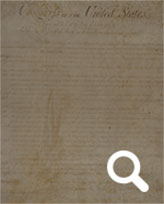Mobilizing for War: The Selective Service Act in World War I
Mobilizing for War: The Selective Service Act in World War I
On May 18, 1917, Congress passed the Selective Service Act, which authorized the Federal Government to temporarily expand the military through conscription. The act eventually required all men between the ages of 21 to 45 to register for military service. Under the act, approximately 24 million men registered for the draft. Of the total U.S. troops sent to Europe, 2.8 million men had been drafted, and 2 million men had volunteered. To commemorate this anniversary, the draft registration cards Irving Berlin, Al Capone, Duke Ellington, Marcus Garvey, Harry Houdini, Fiorello LaGuardia, Norman Rockwell, and Babe Ruth are on exhibit.
In commemoration, the World War I Draft Registration Card for George Herman Ruth was on display in the “Featured Documents” exhibit in the East Rotunda Gallery of the National Archives in Washington, DC, from May 4 – June 7, 2017.
Past Featured Records
-
Frances Perkins: Champion of Workers’ Rights
Thursday, February 29, 2024 – Monday, April 15, 2024
East Rotunda Gallery“I came to Washington to work for God, FDR, and the millions of forgotten plain common workingmen.” —Frances Perkins
Chances are you benefit from the legacy of Frances Perkins,... Read more
70th Anniversary of Brown v. Board of Education of Topeka
Thursday, February 1, 2024 – Wednesday, February 28, 2024
East Rotunda GalleryEquity in Education: 70 Years Later
On May 17, 1954, the Supreme Court delivered a unanimous ruling in Brown v. Board of Education of Topeka that “separate but equal” was unconstitutional in... Read more
250th Anniversary of the Boston Tea Party
Thursday, December 14, 2023 – Wednesday, January 31, 2024East Rotunda GalleryThe Destruction of the Tea
It wouldn’t be known as the “Boston Tea Party” for another 50 years, but the destruction... Read more
Diseños: An Impact of Mexican Cession
Tuesday, June 20, 2023 – Wednesday, October 18, 2023
East Rotunda GalleryAt the end of the Mexican-American War, the United States annexed more than half of Mexico’s territory under the 1848 Treaty of Guadalupe Hidalgo. Under its terms, the U.S. promised to... Read more
Celebrating Anna May Wong
Anna May Wong
National Archives, Records of the Immigration and Naturalization Service“I want to be an actress, not a freak.”
Film legend Anna May Wong’s talent could not be contained by the racist casting of early Hollywood movies. Born Wong Liu Tsong in Los Angeles in 1905,... Read more








